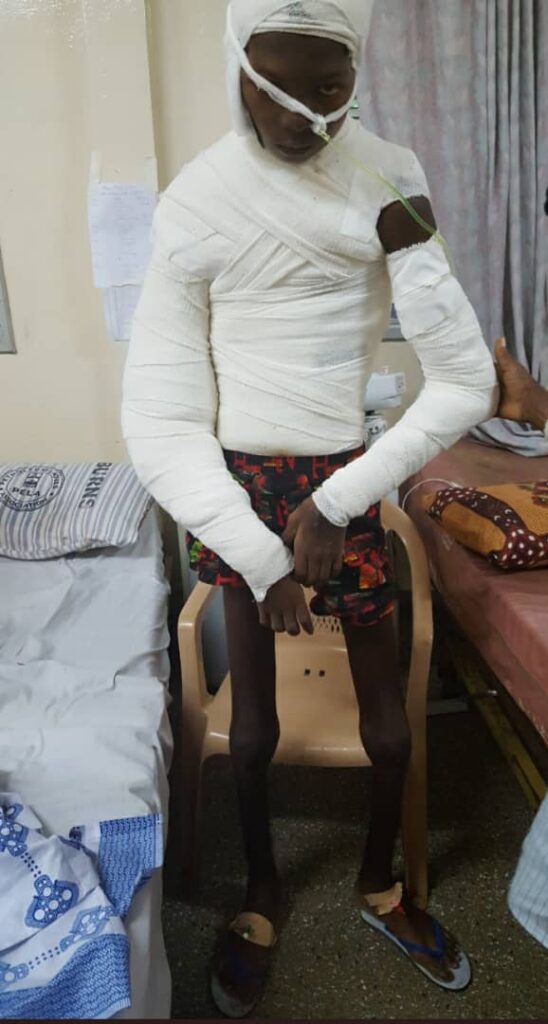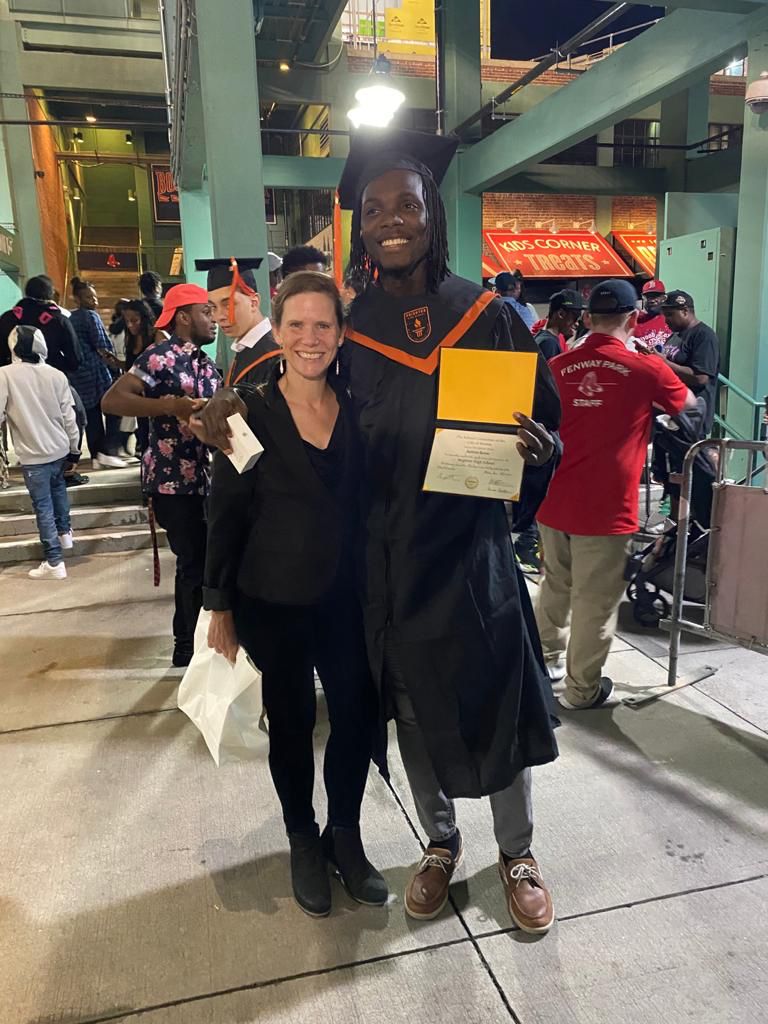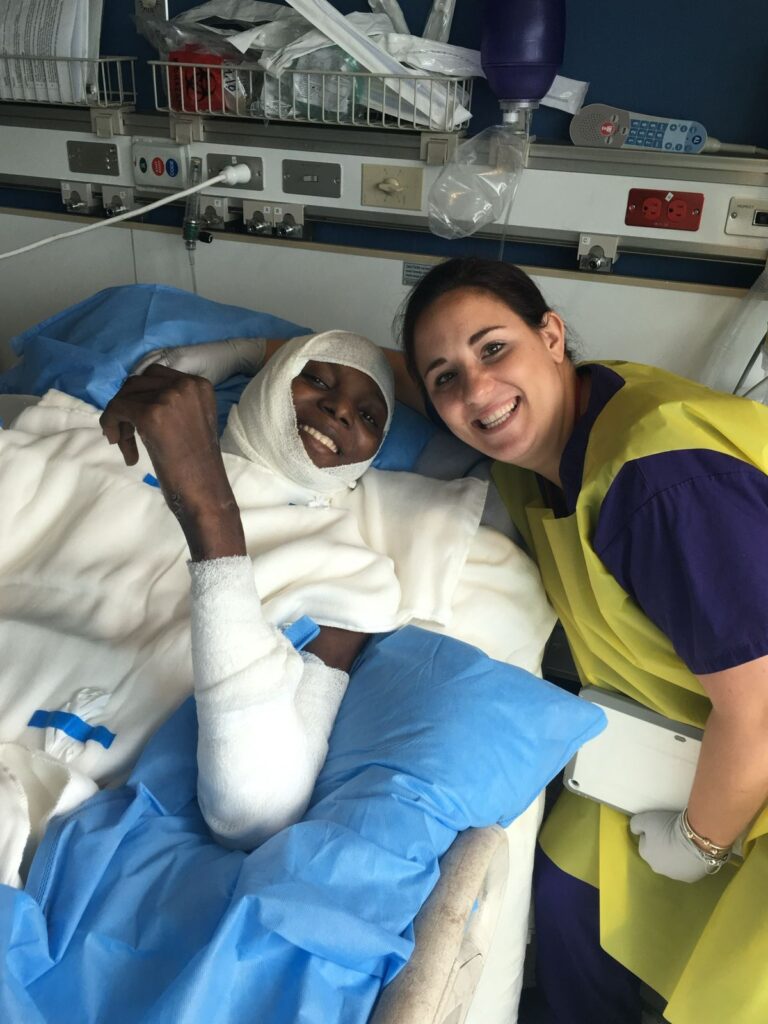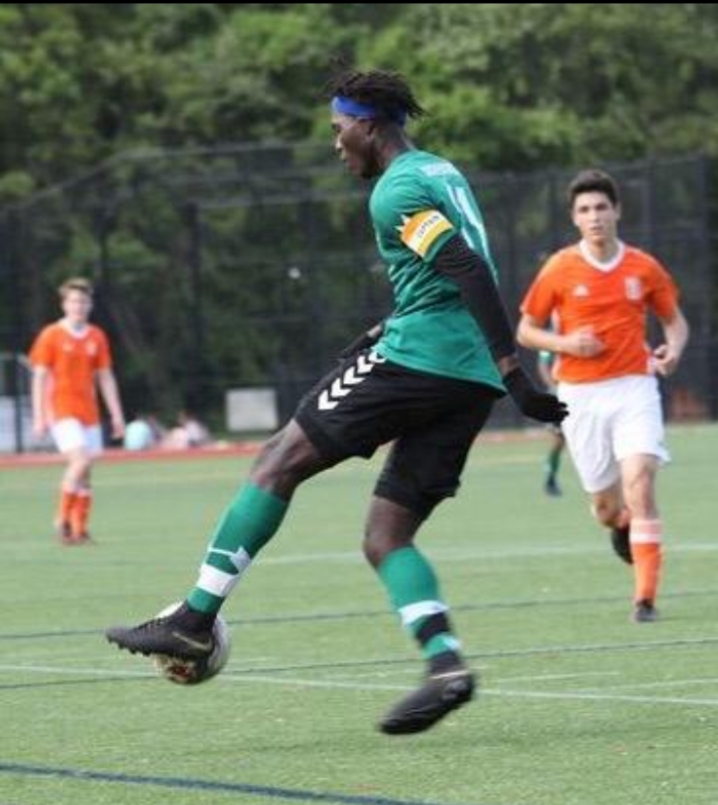The attacker came on the night of Feb. 22nd, 2016, aiming for 73-year-old Robert Dodoo – in his home outside the Ghanaian capital, Accra. The weapon of choice: a paint bucket full of acid. But also at home was Robert’s 16-year-old son, Andy, who instinctively intervened to protect his father. Andy took the brunt of the attack, as most of the acid splashed onto the right side of his body.
While his father’s wounds were more superficial. Andy’s burns were so severe, he’d be hospitalized for the next two months. Early on, with Andy unable to eat, as his muscle mass atrophied and damaged skin peeled from his right arm, leg and groin, all the medical staff could do was try to keep him alive: feeding him intravenously and pumping him with both pain-relief meds and antibiotics – to fight the infections that might prove deadly. Even if Andy survived this trauma, he faced a life of permanent disfigurement.
That is, until the Ghanaian Diaspora roared into action – led by the New York-based non-profit, Sustainable Initiatives & Alliances in Africa. Nine years and six skin-grafts later, Andy today lives pain-free in America – specifically, in Boston – where he’s married and works full-time.

Andy during his hospitalization in Accra.
His older brother, Rifkin, who played a vital role in Andy’s Road to recovery, marvels at his remarkable journey. “I couldn’t have envisioned that he’d be doing as well as he is today,” says Rifkin, via a Zoom call to Accra. “It’s amazing. He even has an American accent!”
Rescuing Andy was a unique project for SIA-Africa, though it also reflects their work on behalf of African youth. Founded in 2012 by Nene Kodjoe, a Ghanaian who’s lived in New York more than 20 years, SIA-Africa matches donors and other resources with organizations on the frontlines. Cooperating with a range of partners, from educational institutions to small businesses, the aim is to make a meaningful difference in the lives of young Africans – from high schoolers to emerging professionals.
By enhancing their educational and economic opportunities, it supports SIA’s broader objective to help transform and develop African institutions – to facilitate a brighter future for youth. Yet, intervening in Andy’s urgent situation was unique, as it centered on enabling him to have any future at all. For him, SIA-Africa was once again a matchmaker: matching people and resources to his life-saving needs.
This extraordinary story begins in the wake of the 2016 attack, when Andy’s older brother, Rifkin, began writing about what had happened to him. Specifically, Rifkin publicized Andy’s saga – and updates about his horrific condition – within the vast network of Accra Academy alumni. Rifkin is a proud graduate.
Rifkin notes that for this “strong and vibrant” community of alums, which stretches from Africa to Europe and North America, Andy’s story became newsworthy: “Because of the nature of the attack and the fact that a 16-year-old intervened to protect an older man, his father. It was a compelling story.”
Among those reading Rifkin’s updates was Kodjoe, a fellow Accra Academy grad whose own younger brother was a good friend of Rifkin’s from their schoolboy days. In learning how little was being done to heal Andy, Kodjoe, from New York, reached out to Rifkin: “He said ‘What are you guys doing about this?’ How are we going to deal with it? We can’t just watch the boy die.’ Those were his exact words.”
With few options available in Ghana, Kodjoe pledged to help a family he’d known for years. SIA-Africa then took two actions: the organization sent Sam Kujo, founder of partner organization Civil Corps, from the US to Accra to assess Andy’s circumstances – and his needs. Next, SIA-Africa created a GoFundMe campaign online, to pay for the best possible care for Andy. This proved to be a life-altering move.

Andy eventually recovered well enough to
graduate from a Boston high school.
While many Westerners are familiar with online fundraising platforms like GoFundMe, as a modern, often-trustworthy way to attract support for worthy causes, Ghanaians had already grown wary of online scams. Especially, those with a heart-wrenching story, claiming to assist some poor victim.
So, this GoFundMe campaign was more than a generous gesture from the Ghanaian Diaspora, says Rifkin. It played a pivotal role: as a nonprofit organization registered in New York, with a New York-based IP address, SIA-Africa lent its name, reputation and institutional credibility to the campaign. That infused it with both credibility and accountability, which brought immediate reassurance to donors.
“Usually, when you want to raise funds for someone who’s in dire need – as Andrew was at the time – it’s going to be difficult unless you’re able to make the story authentic,” says Rifkin. “SIA’s support gave it a certain level of authenticity and accountability for those who wanted to donate.”
It wasn’t only reassuring to Ghanaians in Ghana, like former President J.J. Rawlings who made a significant donation, but for the Ghanaian Diaspora and other generous donors from various ethnic backgrounds. Donations of $10, $20, $50 began to arrive from Europe and America. “Quite a few people know me, so when I mentioned that it was my brother, everyone was like, ‘No way,’” says Rifkin. “When they learned about this New York organization doing it for a boy who’s dying, they thought: ‘We need to help this young man, too.’”
Amid this fundraising, another crucial moment occurred: an American woman named Michele found the GoFundMe campaign and left a comment, suggesting one particular US healthcare partner that might treat Andy for free: the Shriners Hospitals for Children, a network of 22 facilities in the US, Canada and Mexico. That suggestion ultimately led to Shriners Children’s Boston – and its Pediatric Burn Care unit.
Rifkin, who by then was managing the GoFundMe account – and providing updates of Andy’s recovery – Googled Shriners. He called the hospital to explain Andy’s plight; they expressed interest in helping. But first, they sent Rifkin a checklist: to confirm his identity and vaccination status, but also whether the Dodoo family had funds to fly Andy and Rifkin, as his guardian, to Boston. Plus, pay for accommodations.
“The hospital said, ‘Look, if you're able to fulfill these requirements, we'll see what we can do,’” says Rifkin. He secured his brother’s personal data and delivered on those requirements, which led the Shriners Hospital to pledge to treat Andy for free – and eventually perform six skin-graft surgeries.
With Shriners in mind, the GoFundMe fundraising focus turned to covering the financial costs of that trans-Atlantic voyage – for the brothers, plus one more. The hospital in Accra was concerned about Andy’s trip – and his high risk of infection. They wanted a Ghanaian doctor to travel with them – an additional cost that was later covered by SIA-Africa Vice President Sam Stephens.
Other volunteers played crucial roles, too. Marianne Carroll was an SIA-Africa volunteer who invested time and resources to expedite Andy’s US visa, by engaging with both the Ghana Mission to the UN and the US Embassy in Accra. She later also provided accommodation and financial resources to Rifkin in New York City, and visited Andy at Shriners in Boston, on behalf of SIA-Africa.
Meanwhile, Rev. Nana Daquah – a Ghanaian pastor living in Providence, Rhode Island – also generated fundraising through his church, which financed hotel accommodations for Rifkin and Andy.
By the end, the GoFundMe campaign raised $9,000 – not an enormous sum, but enough to cover that journey and deliver Andy to Shriners Children’s Boston. He then spent the next three months there – 88 days, to be exact – as the doctors and nurses provided him with six needed skin surgeries, to repair his body as much as possible.
Next came hours and hours of physical rehabilitation. All at no cost.
“For all initiatives, our mission is to work with our partners and donors to match resources to beneficiary needs,” Kodjoe, the
SIA-Africa Founder, reiterates today. “We had to do everything possible to get Andy out of Ghana. Without the SIA-Africa ‘vehicle,’ we believe he would have died there.”

Andy at Shriners, after his six skin grafts.
Shriners did more than reconstruct Andy’s body; they gave him a second chance to live a normal life. He not only graduated from Brighton High School in Boston, but even more remarkably, he returned to his passion: football. At a high level, too: he played soccer at the Massachusetts College of Liberal Arts.
Andy, now 25, says he might not be alive if not for SIA-Africa and the entire fundraising campaign. Nearly two years ago, he also married a woman who loves him – and his scars. They’ve healed as much as they can. More important, he enjoys life pain-free, with full mobility: “I’m 100% good, really.”
The only discomfort, he notes, is occasionally on his severely burned arm: on hot days, in direct sunlight, it’ll cause a tingling sensation. He says he accepts such inconveniences – and if anyone ever stares at his damaged arm. “If there are scars, there are scars,” he says. “If it gets attention, ‘Hey, this is my body.’”
Looking back, Andy says he was largely oblivious to all the efforts being made on his behalf. “I was just a 16-year-old boy, living my life. But after that incident happened, I was in a terrible situation, obviously. But Rifkin took it upon himself to do something about it. He contacted so many people who could help me, while I was just completely paralyzed – fighting for my life. I didn't really know much about the outside movement and all this SIA stuff. But as time went by, Rifkin told me about the plan to bring me to the US for treatment. At first, I thought he was just saying that to get me to take my medications, because I didn't like taking them. Then I found out this whole thing was actually legit.”

Remarkably, Andy returned to his love of football.
As for the financial support from strangers, Andy says: “I’m speechless about it. So many people who didn’t even know me, but decided to donate and help me get to where I needed to go. For that, all I can say that I’m truly grateful to every single person who helped me through this whole process.”
He says he’s also touched by how the Ghanaian Diaspora, specifically, rallied to support a compatriot. “In a way, that’s how it should be: if one of your own is going through something like that, showing massive support is such a beautiful thing,” says Andy. “And today, look at me. I'm not in as bad a situation as I could be, where I’m completely miserable. Yes, I went through a tragedy and all that stuff. But here I am, moving on with my life, even living a better life. So, for all the people who helped me, they not only did a great thing, but I can also say: It didn't go to waste.”
His big brother, too, marvels at Andy’s evolution, and gives credit to SIA, donors and the Shriners team. “It’s a gift that God gives, if you’re able to help someone like this,” says Rifkin. “It brings me joy to think that Andrew would have been far worse off. But look at him today: he’ll become someone who can also help others in the future. It’s an extraordinary story – and even bigger today than it used to be.”
Andy agrees that one day, he’d like to similarly make a significant difference in someone else’s life. “If you see a friend or a stranger – just a human being – going through something huge like this, like on the edge of dying, of losing their life, if you can do something to support them, you should,” he says. “To help keep the person alive, that’s just greatest thing you can ever do for someone else.”

Andy's story is one of true resilience.
Michael J. Jordan conducted the interviews and wrote this story.